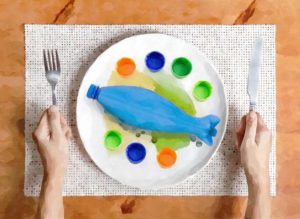Microplastics: Small plastics, big problem
 This glimpse of the future was crafted by Paul Stephenson
This glimpse of the future was crafted by Paul Stephenson
Almost everything we own and buy contains plastics. Look around. If it’s not the chair you’re sitting on, or that part of a pen in your drawer, that bottle in your refrigerator, it may be this thing you’re holding ‒ your smartphone, or a keyboard, or a tablet.
They are everywhere.
But before you blame plastic water bottles and candy wrappers solely for climate change or marine plastic pollution, think again. It turns out, as with many other relationships, sometimes it’s the small things that create the biggest impacts.
And in this case, it’s the plastics that we don’t see, the microplastics, that are about to damage the world we are living in.
We have to wake up, before it’s too late.
It’s not just ‘small’ stuff…
The United Nation’s Environmental Programme (UNEP) identified microplastics as one of the alarming issues that we should keep an eye on as plastic pollution remains the biggest threat to marine biodiversity today. But are we already many years too late?
Based on current rates of plastic pollution, the World Economic Forum predicts that by 2050 there will be more plastic than fish in our oceans.
Microplastics, whilst tiny, pack a big punch. They have been around for more than five decades as microbeads and microfibres ranging in size from 0.5 to 5mm in length.
And we have unknowingly let them into our homes and closets, as they have replaced the natural ingredients of our personal care products, and cosmetics such as toothpaste, facial and body scrubs, and have been manufactured into some of the clothes we love to wear.
However, it’s not actually the products that directly harm us, but rather what happens to them after they go down the drain. These synthetic fabrics (polyesters, acrylics) that we love to wear have been found to release more than 700 000 particles to the environment after just one cycle in the washing machine.
In a study titled ‘Plastic Pollution in the World’s Oceans’, oceanographer Dr Marcus Eriksen and his team went on several expeditions to investigate which kinds of plastic were most polluting the oceans.
To their surprise, significantly outnumbering bigger plastic items such as toothbrushes and the balls in deodorant roll-ons were confetti-sized and smaller shreds of plastics.
Because here’s something that not all people know: plastics rarely degrade. Once these microplastics enter our water system, treatment facilities cannot break them down or filter them out, and they end up in the ocean, mistaken for food by fish and other sea creatures ‒ ultimately infiltrating our lives via our food chain.
“Plastic pollution is surfing onto Indonesian beaches, settling onto the ocean floor at the North Pole, and rising through the food chain onto our dinner tables,” says United Nations Environment Programme (UNEP) Executive Director Erik Solheim. “We’ve stood by too long as the problem has gotten worse. It must stop.”
True enough, not only have microplastics been found in fish and shellfish, they have also been found in beer, honey, tap water, sugar and even air. We just didn’t know it! And, contrary to popular belief, when it comes to microplastics, what we don’t know can actually hurt us.
One Health, one environment
Now, here’s where it gets scarier… While the studies about the effects of microplastics are still at a relatively early stage, initial researches published by UNEP and in the Proceedings of the National Academy of Sciences (PNAS) have discovered that eating plastic particles may cause reduced activity rates, reproductive disruption, weakened schooling behaviour, and altered feeding behaviour among sea creatures. How does this affect humans?
According to the One Health approach, the health of all living things (humans, animals and plants) and everything that surrounds us are interconnected. If something is wrong with the animals and plants around us, then something is likely to go wrong with us, unless we do something about it.
“Microplastic may not only affect species at the organism level; they may also have the capacity to modify population structure with potential impacts on ecosystem dynamics, including bacteria and viruses. Negative effects on the photosynthesis of primary producers and on the growth of secondary producers, potentially result in a reduced productivity of the whole ecosystem and represent a primary concern,” according to a report by the joint Group of Experts on the Scientific Aspects of Marine Environmental Protection (GESAMP).
“Our understanding of the fate and toxicity of microplastics in humans constitutes a major knowledge gap that deserves special attention,” it adds.
So, if we ignore this issue now, it is probable that the ‘plastic soup’ will no longer be metaphorical in the next 20 or 50 years. It will be a reality ‒ and one at a scale we simply can’t ignore.
Can we survive without plastics?
The journey to a plastic-free world may be unimaginable to think about now. The truth is, if almost everything around us is made up of plastic, it’s going to be hard to live without them ‒ especially if they are cheaper, durable and more convenient to use. There are, however, many things that we can do on a personal level to reduce our consumption of plastic – such as using reusable bags for groceries, buying cotton and wool clothing, and using stainless steel water bottles and compostable rubbish bin liners.
In 2017, the US and UK legally banned the use of microbeads. But what if banning plastics entirely is not the answer? “Shifting to a genuine circular economy for plastics is a massive opportunity to close the loop, save billions of dollars, and decouple plastics production from fossil fuel consumption,” says Dame Ellen MacArthur.
According to a report by her foundation, “Manufacturers could redesign plastic items so they could be reused better, and rethink their production methods to make recycling easier. More products could be made out of materials which can be composted on an industrial scale, including rubbish bags for organic waste and food packaging for outdoor events, canteens and fast food outlets.”
In December 2017, the French Government reaffirmed an important commitment towards tackling plastic pollution, by pledging to recycle 100% of plastics by 2025.
A number of large manufacturers such as Nestlé, Adidas, Unilever, and HP Hewlett-Packard have recently started initiatives looking for alternatives to make their products and their packaging sustainable and environment-friendly.
To tackle this crisis, there is an urgent need for governments, industry and entrepreneurs to develop systemic, more innovative, and more audacious solutions that prevent plastic from becoming waste in the first place.
Turning oil to plastic and back again
Priyanka Bakaya is one entrepreneur who has discovered the power of plastic waste – quite literally. Bakaya is an Australian-American entrepreneur and founder of a clean energy company which converts plastic waste into fuel. Her company, Renewlogy, makes diesel, kerosene, light fuels in a process that chemically takes the plastics back down into their basic building blocks without creating toxic emissions in the process. Investors are watching closely.
Meanwhile, China has done the world a favour. In January, China stopped taking the world’s plastics back for recycling for environmental reasons. Recyclers worldwide were left scrambling for alternatives. This is a good thing. What if every country closed its doors to others waste? This could drive greater innovation and new business opportunities that benefit local communities.
In the UK, scientists and engineers from the University of Bath have developed a way of making microbeads from cellulose, which is not only from a renewable source, but also biodegrades into harmless sugars. Work is underway to scale this process for manufacturing.
If offered a choice, consumers will prefer not to rub plastic into their skins when they exfoliate – brands that are earlier adopters of these alternative ‘ingredients’ can create competitive advantage.
So, how might we get products to people without generating plastic waste and mitigate a potential eco-genocide? We’re not sure yet but some smart people and organisations are working on finding solutions.
If nothing else, microplastics have taught us that sometimes the smallest things can make the biggest impact.



